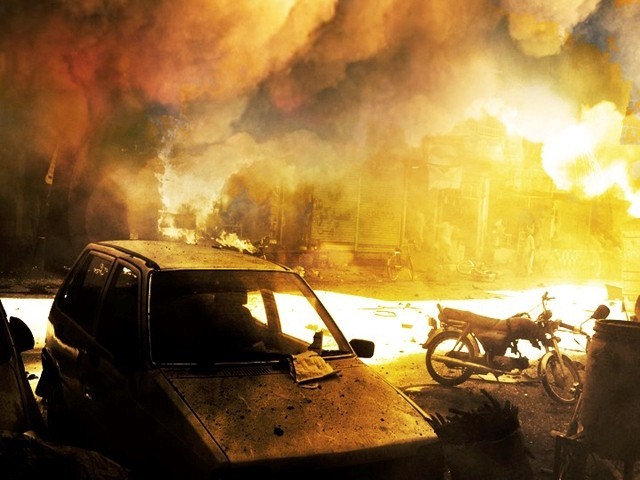
The annual report, State of Human Rights in 2010, also revealed that there were 581 kidnappings for ransom and 16,977 cases of abductions across the country.
Faith based violence claimed the lives of 99 Ahmadis, while 64 people were charged with blasphemy. Violence against various Muslim sects claimed the lives of 418 people and injured 963.
US drones strikes were responsible for 957 extra-legal killings and 1,159 people were killed in 67 suicide attacks.
Below are highlights from State of Human Rights 2010:
Law and law-making
- The parliament achieved a signal success by adopting the 18th Amendment Act through a consensual process and then responding quickly to the Supreme Court’s reservations on the appointment of judges by passing the 19th Amendment.
- Although 30 Acts were passed in 2010 the government had difficulties in expediting legislation. Dozens of Bills passed by the National Assembly were pending adoption by the Senate and the Domestic Violence Bill, duly approved by the National Assembly, lapsed as it could not be pushed through the Senate within the prescribed period.
- Failure to address the issue of the Musharraf period ordinances that were struck down by the Supreme Court posed serious questions regarding the validity of actions taken under the ordinances that were not validated.
Administration of justice
- 2010 was a fairly hectic year for the judiciary. A new procedure for the appointment of judges of superior courts was put in place but at one stage the Supreme Court had to intervene to save the system from collapse in Balochistan and serious strains elsewhere.
- Contempt proceedings against the PCO judges for ignoring the SC’s Nov 3, 2007 order continued but they continued to enjoy their wages without doing any work.
- The National Judicial Policy was claimed to be proving effective.
- The government and the SC remained on a collision course for a better part of the year and at a moment of alarm the SC held midnight sitting and passed an order against any withdrawal of the 2009 notification whereby the judges had been restored.
- The SC dealt with a number of cases relating to NRO beneficiaries, financial scams and irregular actions of the executive. Frequent invocation of the suo motu jurisdiction once again raised the question whether this was the only way to ensure proper governance.
Law and order
- As many as 12,580 people were murdered, while 581 kidnappings for ransom and 16,977 cases of abduction were also reported.
- There were 37,088 cases of vehicle theft or snatching. Police recovered 60,884 illegal weapons.
- US drones strikes were responsible for 957 extra-legal killings.
- 338 people were killed in police encounters. Only 28 ‘suspects’ were injured and captured alive.
- At least 174 people were rescued from illegal police detention.
- 1,159 people were killed in 67 suicide attacks. The fatalities included 1,041 civilians. 2,542 people were killed and 5,062 injured in terrorist attacks.
- 237 political activists and 301 other civilians were killed in targeted killings in Karachi. 81 people were killed in Lyari gang wars.
- 118 people were killed and 40 injured in 117 targeted killings in Balochistan. They included 29 non-Baloch ‘settlers’ and 17 members of the Shia Hazara community. Bodies of 59 missing persons were found in the province.
- NGOs and human rights defenders faced threats and attacks because of their work.
Jails and prisoners
- Continued award of death sentence pushed the death row population to around 8,000, with nearly 6,000 death penalty convicts in Punjab alone.
- The authorised capacity of the country’s 91 prisons was 42,617 persons but 75,586 prisoners were detained there. The number of prisoners at 55 prisons was in excess of sanctioned capacity.
- Of the 12,980 detainees in jails across Sindh, 10,306 were under trial, while 33,809 of the 51,902 detainees in the prisons of Punjab were under trial.
- There were 931 women and 1,154 juvenile detainees in prisons across the country, most of them under trial.
- 72 prisoners died in prisons across the country and another 157 were injured.
- Around 7,000 Pakistanis remained jailed in different countries.
- 356 people were sentenced to death, including seven women and one juvenile.
- 34 new cases of enforced disappearance were reported to HRCP. Bodies of 59 missing persons were recovered from various parts of Balochistan.
Freedom of movement
- Security forces did not allow journalists and the civil society to freely visit the conflict-hit regions. The threat of abduction and target killing in parts of Balochistan and FATA made them virtual no-go areas.
- Delays in issuance of passports impinged on the citizens’ right to freely travel abroad.
- Sectarian violence led to the government placing restrictions on the freedom of movement, especially of clerics, on the pretext of preventing sectarian tensions.
- Names of scores of individuals were placed on the Exit Control List (ECL). The Interior Ministry framed rules for inclusion of names in the ECL.
Freedom of thought, conscience and religion
- 99 Ahmadis were killed in faith-based violence. Impunity for perpetrators of violence against minority communities continued.
- At least 64 people were charged under the blasphemy law, including Aasia Bibi, a Christian farmhand. Three men, including two Christian brothers, accused of blasphemy were killed in police custody.
- 25 of the 102 Sikh families forced to flee Orakzai Agency returned to the area.
- 500 Hindu families from Balochistan migrated to India because of threats to their lives and security.
- 17 members of minority communities were killed in the name of honour by their relatives.
- 73 members of religious minority communities committed suicide and 21 attempted to take their own lives.
- 418 people were killed in violence against various Muslim sects. Another 963 were injured.
Freedom of expression
- 20 journalists and media workers lost their lives in attacks and targeted killings.
- Security forces personnel subjected journalists to physical attacks, intimidation and arbitrary detention. Extremist militants and criminals hired by private individuals also harassed and assaulted them.
- By inserting Article 19-A in the constitution through the 18th Amendment, Pakistan formally recognised the citizens’ right to information.
- Journalists faced difficult economic conditions as many employers did not pay their salaries or substantially delayed payment of salaries to them.
Freedom of assembly
- Use of force by the police and attacks by militants undermined citizens’ right to freedom of assembly.
- In 72 incidents of the use of force against protesters by police, 34 people lost their lives and another 300 suffered injuries.
- Over 300 people were killed in extremists’ attacks on political meetings or religious processions.
- The government frequently invoked legal provisions restricting citizens’ right to freedom of the assembly.
Freedom of association
- The government failed to stamp out activities of the banned extremist organisations
- Government policies were criticised for undermining the labour’s fundamental right of association.
- Non-governmental organisations faced threats and attacks from non-state actors. Several NGOs closed down their offices or reduced field work to prevent harm to their staff.
Political participation
- Relations between political parties, even between coalition partners, remained turbulent and were characterised by discord over national issues.
- Less than 50 per cent members of the National Assembly actively took part in the proceedings. 87 MNAs did not utter a single word during the proceedings in three years (2008-2010) of their five-year term.
- Violence, both political and otherwise, led to the death of over 750 people in target killings in Karachi alone.
- Women parliamentarians remained the most active legislators, introducing nine private members’ bills in the 3rd parliamentary year, and 22 out of the total 26 in the 2nd parliamentary year that ended on March 16, 2010.
- Provincial representatives to the Election Commission of Pakistan could not be appointed.
- The provincial governments did not hold local government elections in 2010, using delaying tactics, and also did not indicate when the elections would be held.
Women
- Domestic Violence (Prevention and Protection) Bill lapsed because it could not be submitted to the Senate in time.
- Federal Shariat Court declared parts of Protection of Women Act 2006 unconstitutional.
- Protection against Harassment of Women at Workplace Act 2010 adopted.
- Women parliamentarians not represented in the committee formed to draft 18th Amendment Bill.
- 791 women were killed in the name of honour.
- 2,903 women were raped, 2,581 of them in Punjab.
- 719 women committed suicide and 414 attempted suicide but their lives were saved.
- There were 931 women detainees in prisons across the country.
Children
- Around 10 million children were affected by the massive floods, 2.5 million of them younger than 5.
- The 18th Amendment recognised free and compulsory education as a right for all children between 5 to 16 years of age. However, allocation of appropriate financial resources to fulfil that commitment remained absent.
- Child labour and abuse of domestic child workers remained widespread.
- 1,154 juveniles were detained in the prisons across the country.
- 170 juveniles committed suicide across Pakistan and another 76 attempted suicide but their lives were saved.
Labour
- Over one million child labourers between the ages of 10 to 14 were working in the country.
- At least 2,294 labourers were freed from debt bondage in Sindh alone
- 5.3 million jobs were lost or affected by flooding in Pakistan.
- Trade-unions protested against confusion about national unions in the wake of the 18th Amendment.
- The new Punjab labour law was criticised for curtailing labour rights.
Education
- Pakistan’s literacy rate was recorded at 57% in 2010
- Floods damaged more than 10,000 schools in the country. Between 5-6% of all schools were damaged. Between 1.5 million to 2.5 million students were affected.
- 2010 was declared “national literacy year”, but the budgetary allocation for education for 2010-2011, was a meagre 2% of the GDP.
- 163 attacks were reported on educational institutions
- Militants killed 22 teachers in Balochistan between January 2008 and October 2010.
- Academic certificates of 54 parliamentarians were declared forged.
Health
- Public sector expenditure on health in 2010 was projected to be 0.54% of the GDP, down 27% over the previous year.
- At least 4,000 Pakistani doctors accepted jobs abroad, creating a vacuum in many hospitals in Pakistan.
- One woman died every 30 minutes in Pakistan due to pre-, neo- or post-natal problems. 1,047,948 cases of tuberculosis were registered in the country. There were over 18 million registered hepatitis patients. Over 1.6 million malaria cases were reported annually. 143 cases of polio were reported in the country. There were more than seven million diabetics and as many as 1.5 million people were blind. There were 150,000 thalassemia patients. Over 7,000 patients were infected with the dengue virus and 31 people died of the disease. 114,000 patients of swine flu were reported in 2010. 97,400 HIV/AIDS cases had been diagnosed, while only 5,000 AIDS patients had been registered.
- 34 per cent of the people suffered from a psychological disorder. 2,399 people committed suicide in the country and another 1,174 attempted suicide mainly because of stress or anxiety on account of illness, domestic disputes, financial problems or unemployment, etc.
- 515 health facilities (5.3 per cent) out of a total of 9,271 health facilities across the country were damaged or destroyed in the floods.
Housing
- There was a housing unit shortfall in excess of 8 million, which was growing by 300,000 houses annually. 30 million people in the country were either homeless or had been accommodated by their relatives.
- More than 50 per cent of the urban population lived in slums in the county. Between 600 to 800 slums sheltered about 7.6 million people in Karachi.
- Nearly 1.9 million houses were destroyed or severely damaged in the floods.
- 173 people were killed and 241 injured in collapse of buildings countrywide.
Environment
- A 55% cut was made in allocations for the Environment Ministry.
- Estimated damage to environment cost Pakistan nearly a billion rupees a day. Annual monetary loss the country suffered due to environmental degradation constituted 6% of the GDP.
- Despite an official ban on deforestation since 1993, 155,000 hectares of forestland were declared non-forest and converted into commercial residential areas.
- 22,000 people in Pakistan lost their lives every year on account of air particulate pollution.
- Solid waste collection agencies only cleared 50% of the waste generated.
- Over 400 million gallons of untreated industrial water from Karachi was being discharged into the sea daily.
Refugees
- 109,383 registered Afghan refugees returned to Afghanistan, while another 1.6 million registered Afghan refugees remained in Pakistan.
- Nearly seven million people were forced from their homes in the floods. Even as floodwaters receded in many areas, millions remained in tents, with their houses destroyed and livelihoods lost.
- There were around 1.3 million conflict displaced in the country.
- At least 400 children went missing during the flood emergency.
- 500 flood-displaced Ahmadi families in South Punjab were denied relief and shelter on account of their faith.



1719211536-0/BeFunky-collage-(81)1719211536-0-165x106.webp)



















COMMENTS
Comments are moderated and generally will be posted if they are on-topic and not abusive.
For more information, please see our Comments FAQ